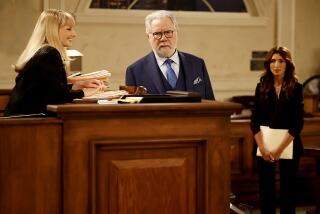‘Vaudeville’ Reflects Spirit of Bygone Era
- Share via
Vaudeville. The word itself has an archaic feeling, a reference to musty old theaters and outdated forms of entertainment.
But vaudeville, in its heyday during the early half of the 20th century, was a virtually all-inclusive entertainment form. Encompassing music, dance, theater and comedy, along with whistlers, plate-spinners, contortionists and every imaginable form of public expression, it was a primary source of pre-radio, pre-movies and pre-television amusement.
And it was, in addition, a training ground for many of the stars who would emerge in those yet-to-come forms of entertainment media.
“Everything I know,” actor James Cagney once said, “I learned in vaudeville.”
A PBS “American Masters” program, “Vaudeville,” examines the form’s golden years in considerable detail. Interviews with such vaudeville veterans as actors Rose Marie, Billy Barty, Iron Eyes Cody and June Havoc; comedians Joey Faye, Morey Amsterdam and Carl Ballantine; and dancers June Taylor and the Nicholas Brothers provide a fascinating array of firsthand anecdotes. And critic John Lahr (the son of vaudevillian-actor Bert Lahr), actor Robert Townsend and author Mel Watkins fill in the gaps with observations about vaudeville’s overall cultural significance.
But the most intriguing moments in the program are the sometimes scratchy, but always fascinating, film clips of vaudevillians in action. Inevitably, the earlier material--which predates the arrival of sound movies in the late ‘20s--can only provide a visual image of their work. But when sound arrived, the movie companies fortunately made extensive use of vaudevillians, preserving performances that provide a strong sense of the medium’s remarkable range--from awkward-looking, tap-dancing children to the physical pyrotechnics of the Nicholas Brothers, from ethnic comedy (loads of it) to the pantomime wit of the inimitable Bert Williams.
The program’s historical overview is useful, if initially a bit unclear in its identification of English music hall and Yiddish theater as primary sources of vaudeville, omitting the obvious inclusion of minstrel shows. Fortunately, a later segment thoroughly examines the history of minstrelsy, as well, underscoring the duality of its implicit racism as well as its importance as a conduit for African American talent.
In the process, “Vaudeville” prominently mentions the sadly under-recognized entertainer-humorist Williams, the country’s first major African American star. (Williams’ important career is sorely in need of attention, and a feature film based on his brief but remarkable life would be a good start.)
The final conclusion of “Vaudeville” is an interesting one--that the form is far from dead, that it has survived in many aspects of popular entertainment, from “The Ed Sullivan Show” to “The Muppet Show,” from halftime shows at sporting events to the purely personal process of creating one’s own vaudeville by surfing from TV channel to TV channel.
* “Vaudeville” airs on “American Masters” at 8 tonight on KCET-TV Channel 28.
More to Read
The biggest entertainment stories
Get our big stories about Hollywood, film, television, music, arts, culture and more right in your inbox as soon as they publish.
You may occasionally receive promotional content from the Los Angeles Times.










